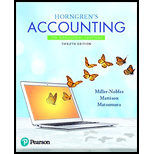
Horngren's Accounting (12th Edition)
12th Edition
ISBN: 9780134486444
Author: Tracie L. Miller-Nobles, Brenda L. Mattison, Ella Mae Matsumura
Publisher: PEARSON
expand_more
expand_more
format_list_bulleted
Concept explainers
Textbook Question
Chapter 6, Problem E6.25E
Computing inventory turnover and days’ sales in inventory
Learning Objective 6
Calm Day reported the following income statement for the year ended December 31, 2019.
| CALM DAY |
Income Statement
Year Ended December 31, 2019
Requirements
- Compute Calm Day’s inventory turnover rate for the year. (Round to two decimal places.)
- Compute Calm Day’s sales in inventory for the year. (Round to two decimal places.)
Expert Solution & Answer
Want to see the full answer?
Check out a sample textbook solution
Students have asked these similar questions
Kindly help me with accounting questions
Financial accounting
Hi expert please help me
Chapter 6 Solutions
Horngren's Accounting (12th Edition)
Ch. 6 - Which principle or concept states that business...Ch. 6 - Which inventory costing method assigns to ending...Ch. 6 - Assume Nile.com began April with 14 units of...Ch. 6 - Suppose Nile.com used the weighted-average...Ch. 6 - Which inventory costing method results in the...Ch. 6 - Which of the following is most closely linked to...Ch. 6 - At December 31, 2018, Stevenson Company overstated...Ch. 6 - Suppose Maestro’s had cost of goods sold during...Ch. 6 - Suppose used the LIFO inventory costing method and...Ch. 6 - Prob. 1RQ
Ch. 6 - Prob. 2RQCh. 6 - Prob. 3RQCh. 6 - Prob. 4RQCh. 6 - Discuss some measures that should be taken to...Ch. 6 - Under a perpetual inventory system, what are the...Ch. 6 - When using a perpetual inventory system and the...Ch. 6 - During periods of rising costs, which inventory...Ch. 6 - What does the lower-of-cost-or market (LCM) rule...Ch. 6 - What account is debited when recording the...Ch. 6 - What is the effect on cost of goods sold, gross...Ch. 6 - When does an inventory error cancel out, and why?Ch. 6 - How is inventory turnover calculated, and what it...Ch. 6 - How is days’ sales inventory calculated, and what...Ch. 6 - When using the periodic inventory system, which...Ch. 6 - When using periodic inventory system and...Ch. 6 - Determining inventory accounting principles...Ch. 6 - Determining inventory costing methods Learning...Ch. 6 - Preparing a perpetual Inventory record and journal...Ch. 6 - Preparing a perpetual inventor, record and journal...Ch. 6 - Preparing a perpetual inventor record and journal...Ch. 6 - Preparing a perpetual inventory record and journal...Ch. 6 - Comparing Cost of Goods Sold under FIFO, LIFO, and...Ch. 6 - Applying the lower-of-cost-or-market rule Learning...Ch. 6 - Determining the effect of an inventory error...Ch. 6 - Computing the rate of inventory turnover and days’...Ch. 6 - Computing periodic inventory amounts—FIFO Learning...Ch. 6 - Computing periodic inventory amounts—LIFO Learning...Ch. 6 - Computing periodic inventory...Ch. 6 - Using accounting vocabulary Learning Objective 1,...Ch. 6 - Comparing inventory methods Learning Objective 2...Ch. 6 - Measuring and journalizing merchandise inventory...Ch. 6 - Measuring and journalizing merchandise inventory...Ch. 6 - Measuring ending inventory and cost of goods sold...Ch. 6 - Comparing amounts for cost of goods sold, ending...Ch. 6 - Comparing cost of goods sold and gross...Ch. 6 - Applying the lower-of-cost-or-market rule to...Ch. 6 - Applying the lower-of-cost-or-market rule to...Ch. 6 - Measuring the effect of an inventory error...Ch. 6 - Correcting an inventory error-two years Learning...Ch. 6 - Computing inventory turnover and days’ sales in...Ch. 6 - Comparing ending merchandise inventory, cost of...Ch. 6 - Computing periodic inventory amounts Learning...Ch. 6 - Accounting for inventory using the perpetual...Ch. 6 - Accounting for inventory using the perpetual...Ch. 6 - Accounting principles for inventory and applying...Ch. 6 - Prob. P6.31APGACh. 6 - Prob. P6A.32APGACh. 6 - Prob. P6.33BPGBCh. 6 - Prob. P6.34BPGBCh. 6 - Accounting principles for inventory and applying...Ch. 6 - Prob. P6.36BPGBCh. 6 - Prob. P6A.37BPGBCh. 6 - Prob. P6.38CTCh. 6 - Prob. P6.39CPCh. 6 - Prob. P6.40PSCh. 6 - Prob. 1CPCh. 6 - Prob. 2CPCh. 6 - Prob. 3CPCh. 6 - Prob. 4CPCh. 6 - Prob. 5CPCh. 6 - Prob. 6CPCh. 6 - Prob. 7CPCh. 6 - Prob. 8CPCh. 6 - Prob. 9CPCh. 6 - Prob. 10CPCh. 6 - Prob. 11CPCh. 6 - Prob. 6.1TIATCCh. 6 - Prob. 6.1DCCh. 6 - Prob. 6.1FSC
Knowledge Booster
Learn more about
Need a deep-dive on the concept behind this application? Look no further. Learn more about this topic, accounting and related others by exploring similar questions and additional content below.Similar questions
arrow_back_ios
SEE MORE QUESTIONS
arrow_forward_ios
Recommended textbooks for you
 Cornerstones of Financial AccountingAccountingISBN:9781337690881Author:Jay Rich, Jeff JonesPublisher:Cengage LearningCentury 21 Accounting Multicolumn JournalAccountingISBN:9781337679503Author:GilbertsonPublisher:Cengage
Cornerstones of Financial AccountingAccountingISBN:9781337690881Author:Jay Rich, Jeff JonesPublisher:Cengage LearningCentury 21 Accounting Multicolumn JournalAccountingISBN:9781337679503Author:GilbertsonPublisher:Cengage Financial And Managerial AccountingAccountingISBN:9781337902663Author:WARREN, Carl S.Publisher:Cengage Learning,
Financial And Managerial AccountingAccountingISBN:9781337902663Author:WARREN, Carl S.Publisher:Cengage Learning, Intermediate Accounting: Reporting And AnalysisAccountingISBN:9781337788281Author:James M. Wahlen, Jefferson P. Jones, Donald PagachPublisher:Cengage Learning
Intermediate Accounting: Reporting And AnalysisAccountingISBN:9781337788281Author:James M. Wahlen, Jefferson P. Jones, Donald PagachPublisher:Cengage Learning


Cornerstones of Financial Accounting
Accounting
ISBN:9781337690881
Author:Jay Rich, Jeff Jones
Publisher:Cengage Learning

Century 21 Accounting Multicolumn Journal
Accounting
ISBN:9781337679503
Author:Gilbertson
Publisher:Cengage

Financial And Managerial Accounting
Accounting
ISBN:9781337902663
Author:WARREN, Carl S.
Publisher:Cengage Learning,


Intermediate Accounting: Reporting And Analysis
Accounting
ISBN:9781337788281
Author:James M. Wahlen, Jefferson P. Jones, Donald Pagach
Publisher:Cengage Learning
Chapter 6 Merchandise Inventory; Author: Vicki Stewart;https://www.youtube.com/watch?v=DnrcQLD2yKU;License: Standard YouTube License, CC-BY
Accounting for Merchandising Operations Recording Purchases of Merchandise; Author: Socrat Ghadban;https://www.youtube.com/watch?v=iQp5UoYpG20;License: Standard Youtube License